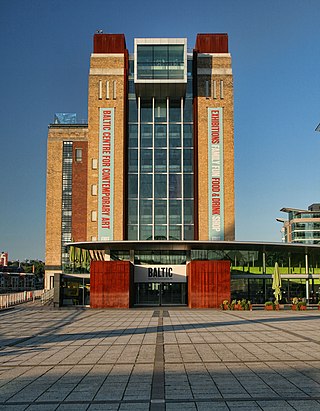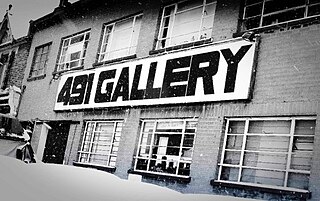
Tate Modern is an art gallery in London, housing the United Kingdom's national collection of international modern and contemporary art, defined as from after 1900, and forms part of the Tate group together with Tate Britain, Tate Liverpool and Tate St Ives. It is located in the former Bankside Power Station, in the Bankside area of the London Borough of Southwark.

Silvertown is a district in the London Borough of Newham, in east London, England. It lies on the north bank of the Thames and was historically part of the parishes of West Ham and East Ham, hundred of Becontree, and the historic county of Essex. Since 1965, Silvertown has been part of the London Borough of Newham, a local government district of Greater London. It forms part of the London E16 postcode district along with Canning Town and Custom House.

Sir Henry Tate, 1st Baronet, was an English sugar merchant and philanthropist, noted for establishing the Tate Gallery in London.

The Greenwich Peninsula is an area of Greenwich in South East London, England. It is bounded on three sides by a loop of the Thames, between the Isle of Dogs to the west and Silvertown to the east. To the south is the rest of Greenwich, to the south-east is Charlton.
Graham Vivian Sutherland was a prolific English artist. Notable for his paintings of abstract landscapes and for his portraits of public figures, Sutherland also worked in other media, including printmaking, tapestry and glass design.

Baltic Centre for Contemporary Art is a centre for contemporary art located on the south bank of the River Tyne in Gateshead, Tyne and Wear, England. It hosts a frequently changing variety of exhibitions, events, and educational programmes with no permanent exhibition. The idea to open a centre for contemporary arts in Gateshead was developed in the 1990s, which was a time of regeneration for the local area—the Sage and Gateshead Millennium Bridge was also being conceived of in this period.

The Lower Lea Valley is the southern end of the Lea Valley which surrounds the River Lea in eastern Greater London. It is part of the Thames Gateway redevelopment area and was the location of the 2012 Summer Olympics.

Tate & Lyle PLC is a British-headquartered, global supplier of food and beverage products to food and industrial markets. It was originally a sugar refining business, but from the 1970s, it began to diversify, eventually divesting its sugar business in 2010. It specialises in turning raw materials such as corn and tapioca into ingredients that add taste, texture, and nutrients to food and beverages. It is listed on the London Stock Exchange and is a constituent of the FTSE 250 Index.

Ravensbourne University London is a digital media and design university, with vocational courses in fashion, television and broadcasting, interactive product design, architecture and environment design, graphic design, animation, moving image, music production for media and sound design.
The Paul Mellon Centre for Studies in British Art is a scholarly centre in London devoted to supporting original research into the history of British Art. It was founded in 1970 and endowed by a gift from Paul Mellon. Since 1996, it has been situated at 16 Bedford Square in a Grade I listed building. This building houses an outstanding library of 26,000 publications focused on British art and architecture, and over 25 collected archives which include papers of eminent art historians such as Ellis K. Waterhouse, Oliver Millar, Brian Sewell and Brinsley Ford. It also holds the records of its own institutional archives, including a growing oral history collection. The centre compiled its own photographic archive from 1970 to 1996 and now also holds the Tate photographic archive. All of these research collections are available to consult in the centre's Public Study Room.

The 491 Gallery was a squatted self-managed social centre and multi-disciplinary gallery in Leytonstone, London, England, that operated from 2001 to 2013. Taking its name from its street number, 491 Grove Green Road, the former factory was home to a community-led art organisation and served as an exhibition space for a diverse range of artists of different origins working in varied media. It contained a range of art and music studios, which were used to host workshops, classes and musical rehearsals. The building was subsequently demolished in 2016.

Streatham Library is located at 63 Streatham High Road, Streatham, in the London Borough of Lambeth, England. The Library opened in 1890, and is one of several historical libraries in the vicinity which were built by Henry Tate. It is a public library.

The Millennium Mills is a derelict turn of the 20th century flour mill in West Silvertown on the south side of the Royal Victoria Dock, between the Thames Barrier and the ExCeL London exhibition centre alongside the newly built Britannia village, in Newham, London, England. The Mills are currently undergoing a major renovation as part of a £3.5billion redevelopment of Silvertown.
The conservation and restoration of time-based media art is the practice of preserving time-based works of art. Preserving time-based media is a complex undertaking within the field of conservation that requires an understanding of both physical and digital conservation methods. It is the job of the conservator to evaluate possible changes made to the artwork over time. These changes could include short, medium, and long-term effects caused by the environment, exhibition-design, technicians, preferences, or technological development. The approach to each work is determined through various conservation and preservation strategies, continuous education and training, and resources available from institutions and organization across the globe.

Ernesto Gottfried Schmitt is an American-born entrepreneur and investor. A founder of PeopleSound, Beamly and DriveTribe, he also founded venture capital fund The Craftory, with a $600m first fund for consumer goods challenger brands.

Revolving Torsion is a 1972–73 kinetic sculpture and fountain by the Russian-born Constructivist artist Naum Gabo. It was commissioned for the Tate Gallery and has been on long-term loan to the Guy's and St Thomas' Charity for display at St Thomas' Hospital in Lambeth, London, since 1975. It was given Grade II* listed status in January 2016.

St Mark's Church, Silvertown or St Mark's Church, Victoria Docks is a former church building in Silvertown in east London, located on North Woolwich Road. It takes one of its names from the nearby Royal Docks. It was listed as Grade II* in 1971 and now houses the Brick Lane Music Hall.

St Luke's Church, Canning Town or St Luke's Church, Victoria Docks is a Church of England church, originally housed in a building on Boyd Road in the Royal Docks area of West Ham in east London.
St Barnabas' Church, West Silvertown was a Church of England church in Silvertown, east London. It was opened in 1882 on Eastwood Road as a mission church of St Mark's Church, Silvertown. In the 1917 Silvertown explosion its chancel and iron hall were destroyed, leaving the church to use temporary buildings until the completion of a new church and the formation of a separate parish for it, both in 1926. The new parish was mainly drawn from St Mark's, though it also took a small part of the parish of St Luke's Church, Canning Town. The vicar of St John's Church, North Woolwich administered it after 1945. The parishes of St John, St Mark and St Barnabas were merged in 1974 to form the parish of North Woolwich with Silvertown.

Silvertown War Memorial, also known as Silvertown Explosion Memorial, is a war memorial in Silvertown, in East London. It serves as a memorial for the workers at the Brunner Mond chemical plant who were killed on active service during the First and Second World Wars, while also commemorating the people killed in the Silvertown explosion on 17 January 1917. It became a Grade II listed building in 1999.


















